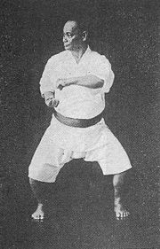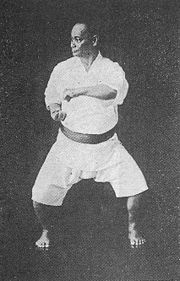
Naihanchi
Encyclopedia
| Japanese Japanese language is a language spoken by over 130 million people in Japan and in Japanese emigrant communities. It is a member of the Japonic language family, which has a number of proposed relationships with other languages, none of which has gained wide acceptance among historical linguists .Japanese is an... : |
,, |
| Ryukyuan Ryukyuan languages The Ryukyuan languages are spoken in the Ryukyu Islands, and make up a subgroup of the Japonic, itself controversially a subgroup of Altaic.... : |
,, |
| Shotokan Shotokan is a style of karate, developed from various martial arts by Gichin Funakoshi and his son Gigo Funakoshi . Gichin was born in Okinawa and is widely credited with popularizing karate through a series of public demonstrations, and by promoting the development of university karate clubs, including... : |
, old: |
(or ) is a karate
Karate
is a martial art developed in the Ryukyu Islands in what is now Okinawa, Japan. It was developed from indigenous fighting methods called and Chinese kenpō. Karate is a striking art using punching, kicking, knee and elbow strikes, and open-handed techniques such as knife-hands. Grappling, locks,...
Kata
Kata
is a Japanese word describing detailed choreographed patterns of movements practised either solo or in pairs. The term form is used for the corresponding concept in non-Japanese martial arts in general....
, performed in straddle stance ( / ). It translates to 'internal divided conflict'. The form makes use of in-fighting techniques (i.e. tai sabaki
Tai sabaki
is a term from Japanese martial arts and which relates to 'whole body movement', or repositioning. It can be translated as body-management. It is a term used widely in kendo, jujutsu, aikido, judo, karate and ninjutsu...
(whole body movement)) and grappling. In Shorin-Ryu and Matsubayashi-Ryu Naihanchi Shodan is the first Ni Kyu (Brown Belt Kata) although it is taught to Yon Kyu (Green Belts) occasionally before Evaluations for the Ni Kyu rank. It is also the first Shorin-Ryu kata to start with a technique to the right instead of the left. There are three modern kata derived from this (Shodan, Nidan and Sandan). Some researchers believe Nidan and Sandan were created by Anko Itosu
Anko Itosu
is considered by many the father of modern karate, although this title is also often given to Gichin Funakoshi because the latter spread karate throughout Japan.- Biography :...
, but others believe that it was originally one kata broken into three separate parts (probably due to constraints of space). The fact that only Naihanchi/Tekki Shodan has a formal opening suggests the kata was split.
It has been suggested the kata was originally developed when fighting against a wall / ledge / narrow confined space which is unlikely; however it could be used for this purpose. Whilst the kata is linear, moving side to side, the techniques can be applied against attackers at any angle. The side to side movements in a low stance build up the necessary balance and strength for fast footwork and body shifting. The kata are intricate strategies of attacking and defensive movement, done in the kiba dachi, for the purpose of conditioning the legs to develop explosive power. If one rotates one's torso a few degrees to one side or the other while performing Naihanchi/Tekki, the result is the Hachi-monji, or figure eight stance. This has been called the basics of all karate. Some researchers believe the form is a non-ballistic two-man grappling exercise.
History
Itosu is reported to have learned the kata from Sokon MatsumuraSokon Matsumura
was one of the original karate masters of Okinawa. His life is reported variously as or or or -Early history:...
, who learned it from a Chinese man living in Tomari
Tomari, Okinawa
is a neighborhood in Naha, Okinawa Prefecture, Japan, where the Tomari Terminal of the port of Naha is located. The terminal is used for ferries and passenger vessels which connect Naha and neighboring islands....
. Itosu is thought to have changed the original kata. The form is so important to old style karate
Karate
is a martial art developed in the Ryukyu Islands in what is now Okinawa, Japan. It was developed from indigenous fighting methods called and Chinese kenpō. Karate is a striking art using punching, kicking, knee and elbow strikes, and open-handed techniques such as knife-hands. Grappling, locks,...
that Kentsu Yabu
Kentsu Yabu
was a prominent teacher of Shōrin-ryū karate in Okinawa from the 1910s until the 1930s, and was among the first people to demonstrate karate in Hawaii.- History :...
(a student of Itosu) often told his students ‘Karate begins and ends with Naihanchi’ and admonished his students must practice the kata 10,000 times to make it their own. Before Itosu created the Pinan
Pinan series
]The kata are a series of five empty hand forms taught in many karate styles. The Pinan kata originated in Okinawa and were adapted by Anko Itosu from older kata such as Kusanku and Channan into forms suitable for teaching karate to young students. When Gichin Funakoshi brought karate to Japan,...
(Heian) kata, Naihanchi would traditionally be taught first in Tomari-te and Shuri-te schools, which indicates its importance. Gichin Funakoshi
Gichin Funakoshi
was the creator of Shotokan karate, perhaps the most widely known style of karate, and is attributed as being the 'father of modern karate.' Following the teachings of Anko Itosu, he was one of the Okinawan karate masters who introduced karate to the Japanese mainland in 1921...
learned the kata from Anko Asato
Anko Asato
was an Okinawan master of karate. He and Ankō Itosu were the two main karate masters who taught Gichin Funakoshi, the founder of Shōtōkan-ryū karate. Funakoshi appears to be the source of most of the information available on Asato...
. Funakoshi renamed the kata Tekki (Iron Horse) in reference to his old teacher, Itosu, and the form's power.

Motobu Choki
The Okinawan karateka , younger brother of karateka Motobu Chōyū, was born in Akahira Village in Shuri, Okinawa, then capital of the Ryūkyū Kingdom....
. He states the kata was imported from China
China
Chinese civilization may refer to:* China for more general discussion of the country.* Chinese culture* Greater China, the transnational community of ethnic Chinese.* History of China* Sinosphere, the area historically affected by Chinese culture...
, but is no longer practiced there. Motobu learned the kata from Sokon Matsumura, Sakuma Pechin
Pechin
The is an Okinawan term for the warrior class of the former Ryūkyū Kingdom , the class equivalent of the Japanese Samurai...
, Anko Itosu
Anko Itosu
is considered by many the father of modern karate, although this title is also often given to Gichin Funakoshi because the latter spread karate throughout Japan.- Biography :...
and Kosaku Matsumora. Motobu taught his own interpretation of Naihanchi, which included te (Okinawan form of martial arts which predates karate) like grappling and throwing techniques.
In the earlier days of karate training, it was common practice for a student to spend 2-3 years doing nothing but Naihanchi/Tekki, under the strict observation of their teacher. Motobu Choki, famous for his youthful brawling at tsuji (red-light district), credited the kata with containing all that one needs to know to become a proficient fighter.
The Tekki series of kata were renamed by Funakoshi from the Naihanchi kata, which were derived from an older, original kata, Nifanchin. Nifanchin was brought to Okinawa via Fuzhou, China, at some point in the long history of trade between the two kingdoms. It was broken into three distinct segments, possibly by Anko Itosu
Anko Itosu
is considered by many the father of modern karate, although this title is also often given to Gichin Funakoshi because the latter spread karate throughout Japan.- Biography :...
, Tokumine Pechin
Pechin
The is an Okinawan term for the warrior class of the former Ryūkyū Kingdom , the class equivalent of the Japanese Samurai...
, or Motobu Choki
Motobu Choki
The Okinawan karateka , younger brother of karateka Motobu Chōyū, was born in Akahira Village in Shuri, Okinawa, then capital of the Ryūkyū Kingdom....
. The kata are performed entirely in Kiba dachi
Horse stance
The horse stance is an important posture in Asian martial arts and takes its name from the position assumed when riding a horse. It is called mǎbù in Chinese, in Japanese, kekuda or kuda-kuda in Malay, asvavadivu in Malayalam, and juchum seogi or annun seogi in Korean...
("Horse stance"). The name Tekki itself (and Nifanchin) translates to "Iron Horse."
Tekki Shodan (鉄騎初段), literally meaning "Iron Horse Riding, First Level", is the first of the series, followed by Tekki nidan and Tekki sandan.
In the 1960’s a kung fu practitioner, Daichi Kaneko, studied a form of Taiwanese White Crane Boxing, known as Dan Qiu Ban Bai He Quan (Half Hillock, Half White Crane Boxing). Kaneko, an acupuncturist who lived in Yonabaru, Okinawa, taught a form called Neixi (inside knee) in Mandarin. This form includes the same sweeping action found in the nami-gaeshi (returning wave) technique of Naihanchi. Neixi is pronounced Nohanchi in Fuzhou
Fuzhou
Fuzhou is the capital and one of the largest cities in Fujian Province, People's Republic of China. Along with the many counties of Ningde, those of Fuzhou are considered to constitute the Mindong linguistic and cultural area....
dialect, which could indicate Neixi is the forerunner to Naihanchi.
Analysis
- Perfectly symmetrical katas
- Generous use of kiba dachi trains legs and knees well
- Nami ashi is difficult to master.
- Proper use of hips and body is important and is difficult to master when in kiba dachi.
- Has the simplest embusenEmbusen] is a Japanese term used in karate to refer to the spot where a kata begins, as well as its line of movement. Nearly all kata start and end on exactly the same embusen point. This word is also commonly romanized as enbusen....
of all katas
External links
- Shotokan Tekki Shodan kata diagram
- Shotokan Tekki Nidan kata diagram
- Shotokan Tekki Sandan kata diagram
- Naihanchi Shodan and Nidan
Sources
- Akari-ki Karate: Naihanchi
- Joe Swift - Roots of Shotokan: Funakoshi's Original 15 Kata; Part 2 - Pinan, Naihanchi, Kushanku & Passai Kata http://www.fightingarts.com/reading/article.php?id=221
- Nathan Johnson – Barefoot Zen: The Shaolin Roots of Kung Fu and Karate, Weiser, York Beach, 2000.
- Shoshin Nagamine – The Essence of Okinawan Karate-Do, Tuttle, Boston, 1998.
- Mark Bishop – Okinawan Karate, Tuttle, Boston, 1999.
- Shoshin Nagamine – Tales of Okinawa’s Great Masters, Tuttle, Boston, 1999.
- Bruce D. Clayton - Shotokan's Secret: The Hidden Truth Behind Karate's Fighting Origins, Black Belt Communications, 2004.

